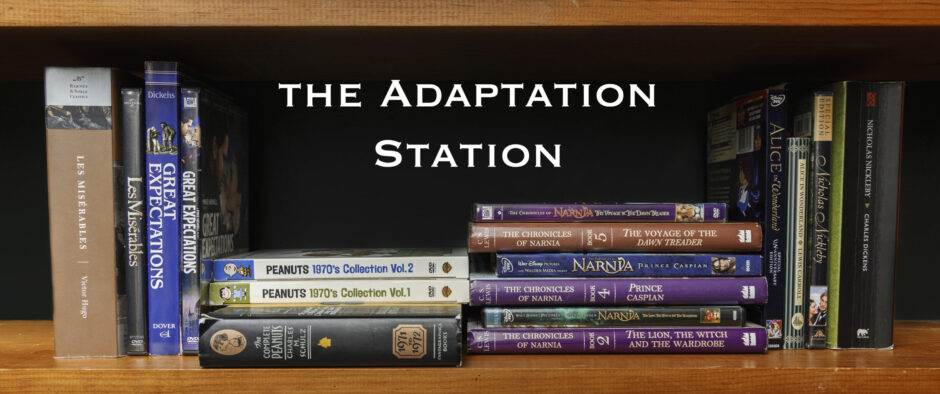In The Sound of Music‘s words, let’s start at the very beginning. Well, OK, not the very beginning. That would require getting into the complete oral and literary history of Cinderella. Let’s start with 1957 when CBS did a musical version of the iconic fairy tale on live television. In 1965, they did another TV-movie version of the musical and in 1997, the Wonderful World of Disney did yet another. While each of the three movies features (mostly) the same songs, each has a different script and it’s interesting to compare and contrast their individual strengths and weaknesses.
Rodgers and Hammerstein’s Cinderella (1957)

The original version of the musical directed by Ralph Nelson (Lilies of the Field, Charly) is the one people are least likely to have grown up watching. Unlike the others, it only aired on TV twice and second time was as part of PBS’s Great Performances in 2004. It’s also the one that modern viewers are least likely to find appealing. While it was broadcast in color, the only surviving recordings of it are in black-and-white. The sets are very obviously sets-well, that’s true of the other two movie versions too but these sets, combined with the slightly fuzzy black-and-white cinematography, have a rather claustrophobic feel. And while many of the actors were big stars back in the day, only Julie Andrews is a recognizable name now. That’s too bad because there’s a lot to love about this little museum piece and it’s a grave injustice that NBC’s live musical version of Peter Pan played so much more often on television.[1]I much prefer the filmed staging of that show from 2000. See my blog post for details.
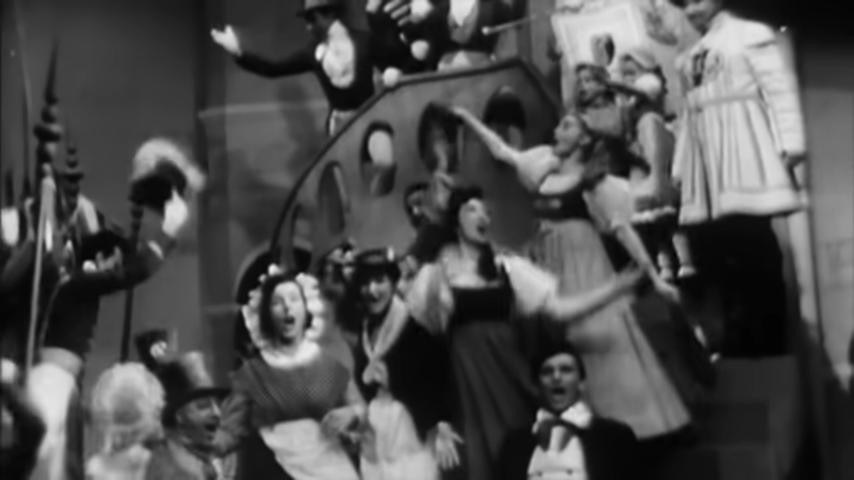
This version’s most obvious strength, of course, is one it shares with the other two: the songs by legendary musical theatre duo, composer Richard Rodgers and lyricist Oscar Hammerstein II. While this musical is considerably less adult than Oklahoma, The King and I or South Pacific, its set of showtunes is just as consistently sparkling. In fact, I’d set this soundtrack against that of any musical this blog has covered. I love the running joke in the opening song, The Prince Is Giving a Ball, with the ridiculous full names of each royal family member and the Stepsisters’ Lament in which they disparage their rival for the Prince (Jon Cypher)’s affections.
She’s a frothy little bubble
With a flimsy kind of charm
And with very little trouble,
I could break her little arm.
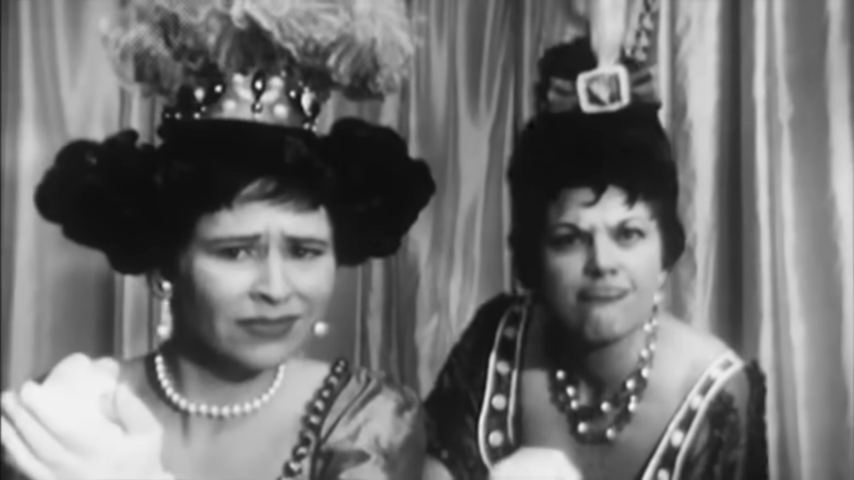
And the songs have more than wit to recommend them. There are also two beautiful love duets for Cinderella (Andrews) and the prince: the ecstatic Ten Minutes Ago and the melancholier and more conflicted Do I Love You Because You’re Beautiful?
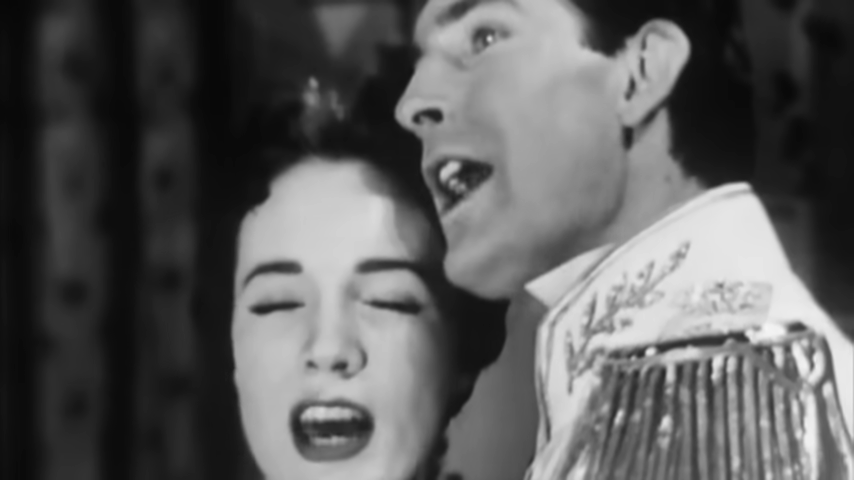
There is one forgettable song in the musical, Your Majesties, in which the royal chef (Iggie Wolfington according the IMDB) and the royal steward (George Hall) present the expense list for the ball to the king (Howard Lindsay) and queen (Dorothy Stickney.) Neither of the later versions retains that one and they’re probably right not to do so.[2]The 1997 movie unwisely incorporates part of it into The Prince Is Giving a Ball with new lyrics. Even that one isn’t bad by any means though it’s just not nearly as memorable as the other songs.
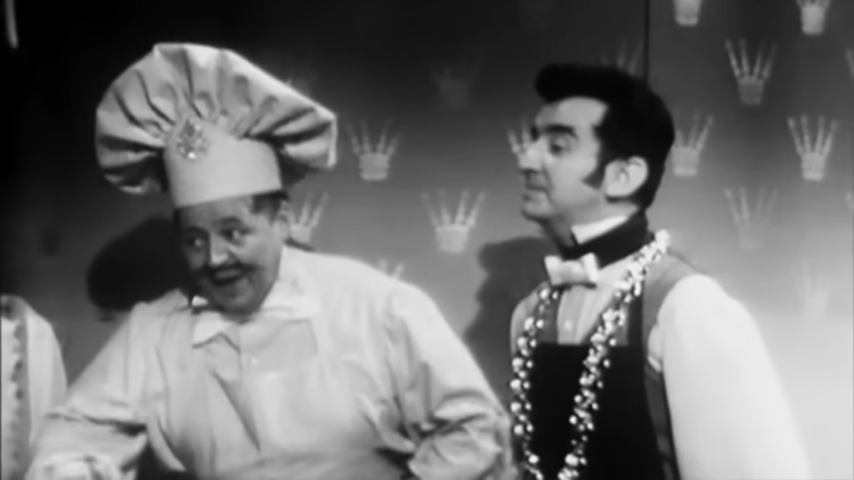
What this version has that the other two don’t is a script by Hammerstein as well as lyrics, meaning it’s just as witty and entertaining. I love the ironically named stepsisters, dour Joy (Alice Ghostly) and clueless Portia (Kaye Ballard.)[3]To understand why the name Portia is ironic for a dumb character, check out The Merchant of Venice.
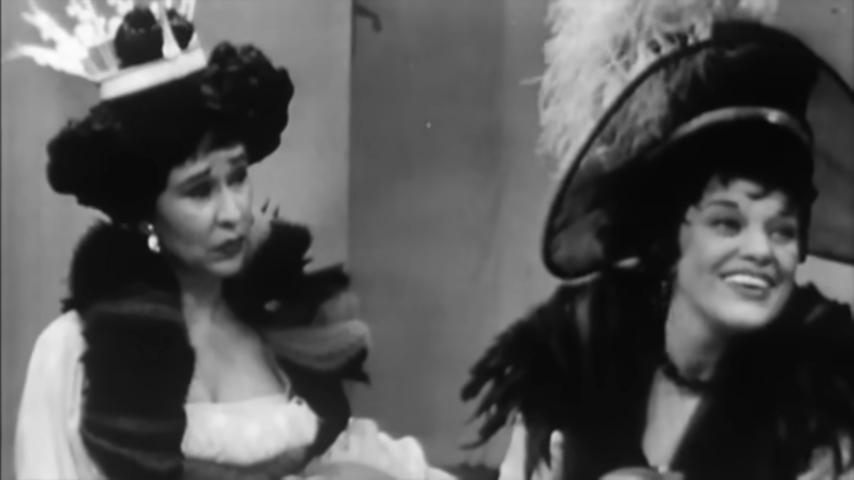
The characters of the king and queen are also a hoot and their relationships with each other and with their son end up being surprisingly touching.[4]Perhaps because Lindsay and Stickney were a couple in real life.
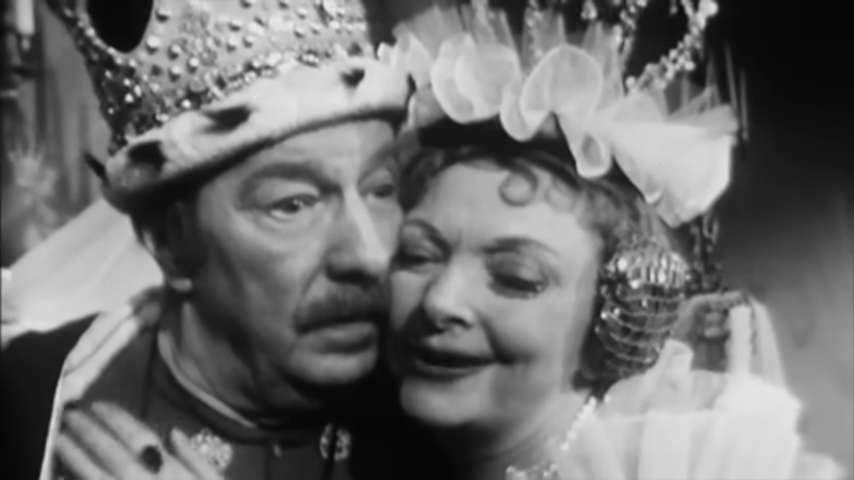
Another great character is the counterintuitively pragmatic and no-nonsense fairy godmother (Edie Adams.) She might be my favorite version of that character in any Cinderella retelling. Actually, she resembles another counterintuitively no-nonsense woman with supernatural powers whom Julie Andrews would go on to play.[5]Do I really need to name her?
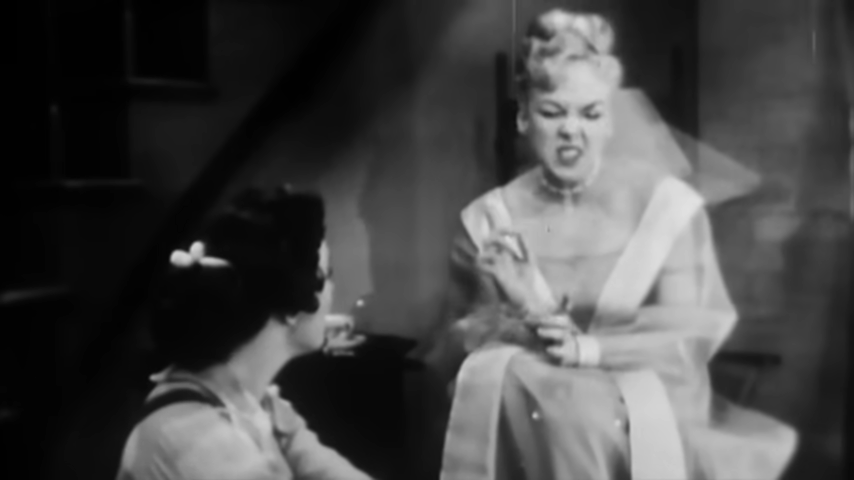
If this script has a shortcoming, it’s unfortunately the character of Cinderella herself who is always either cheerful or sad, never anything else. In my experience, the character can be a lot more interesting than that. Of course, I realize this is supposed to be a fluffy, tongue-in-cheek version of the story aimed at children, so it’d be beside the point to expect anything too dramatic. But Disney movies are also known for being fluffy and aimed at children and their animated Cinderella character showed a wider emotional range seven years prior to this one and was the more compelling for it. Here the role feels like a waste of Julie Andrews’ charisma though not of her singing voice. It’s also odd that the movie seems to set up a character arc for the heroine on which it doesn’t really follow through. The fairy godmother initially advises her to act on her own behalf and not just sit around wishing and dreaming. (Remember what I mentioned about her characterization being counterintuitive.) Cinderella agrees with the sentiment but says she can never think of what to do. Later, in the scene of every single lady in the kingdom trying on the glass slipper, there’s a twist on the story and it looks like Cinderella is going to be the one to approach the prince rather than waiting for him to find her. But then she chickens out and the godmother has to intervene to save the day, so I’m not really sure what the intended message is supposed to be.[6]Interestingly, Hammerstein wrote a stage version, not to be confused with the 2013 Broadway version with a book by Douglas Carter Beane, that fixes this somewhat. Still, as I wrote, things like that are largely beside the point of this movie.
Rodgers and Hammerstein’s Cinderella (1965)
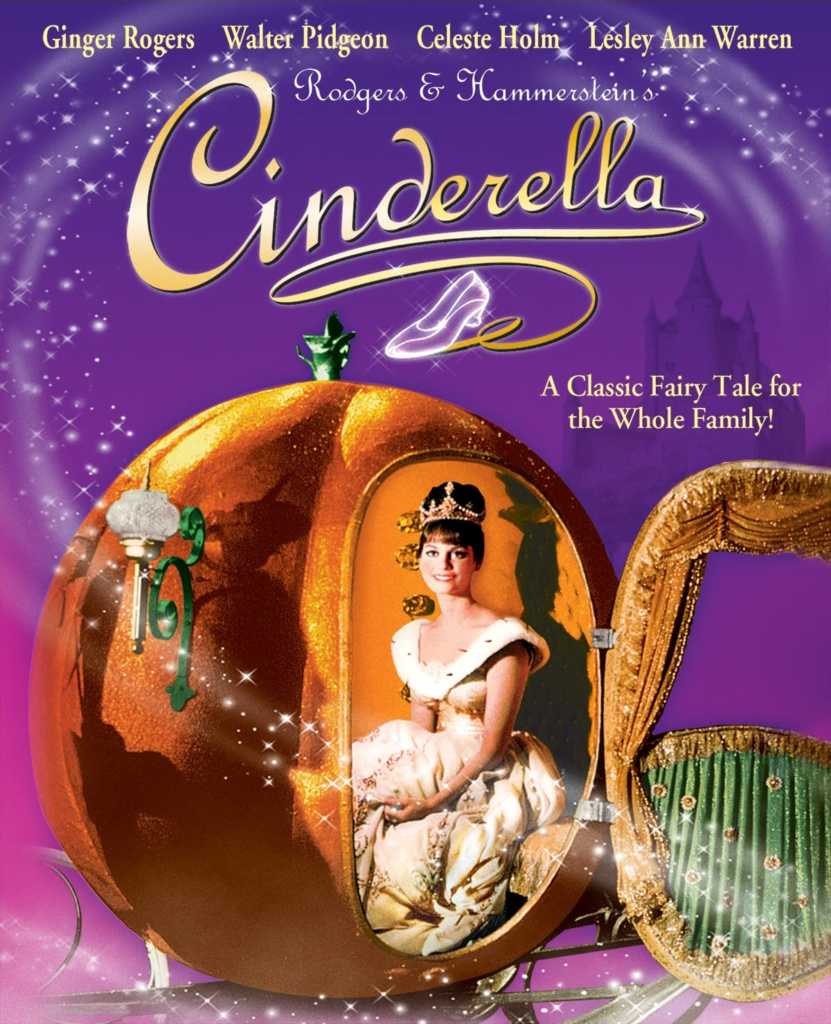
The 1957 production kept its setting vague. The first thing you’ll notice about this one directed by Charles S. Dubin is that it’s explicitly set in a medieval kingdom albeit, after the tradition of fairy tale movies, a generic one without much attention to historical accuracy. This is in keeping with how the new script by Joseph Schrank plays the story straight whereas Hammerstein’s original script played it for laughs. That’s not necessarily a bad thing. I love a good self-aware tongue-in-cheek Cinderella but, in part because it’s so easy to take that approach with this story, there’s something refreshing about a straightforward retelling that doesn’t wink at the audience.
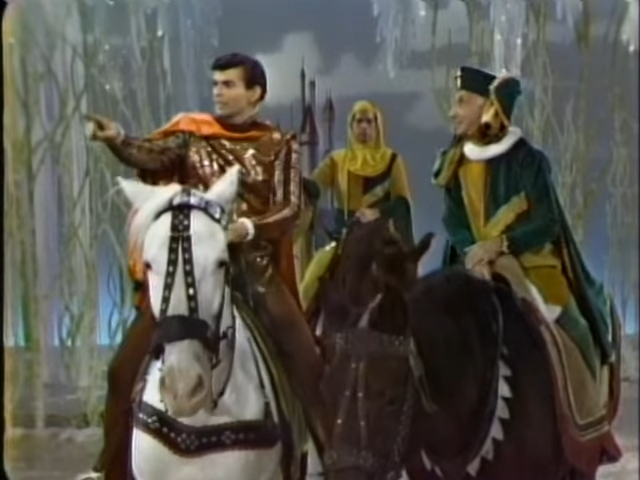
I’ll even say this improves on the 1957 version in some ways. While the bossy and ungrateful stepmother there (who was played by Ilka Chase by the way) certainly wasn’t nice to Cinderella, she wasn’t as nasty as the one here (Jo Van Fleet.) In her first scene, Cinderella (Lesley Ann Warren) actually says that her stepmother will beat her for talking to anyone without her permission. This creates more of a driving need for her to get away from her stepfamily, making the story more engaging. The 1957 version was also limited by technology when it came to showing Cinderella’s rags[7]They’re really more like work clothes but never mind. transforming into finery. Julie Andrews’s Cinderella just put a fancy wrap over them and then after the commercial break, she took it off to reveal she’d changed into a ballgown. The transformation in this 1965 production is far from an impressive special effect but it’s a big moment as it should be. That being said, this isn’t the most interesting straightforward retelling of Cinderella. At times, it’s downright dull, mainly during the scenes with the king (Walter Pidgeon) and the queen (Ginger Rogers) who are nowhere near as much fun as their 1957 counterparts.
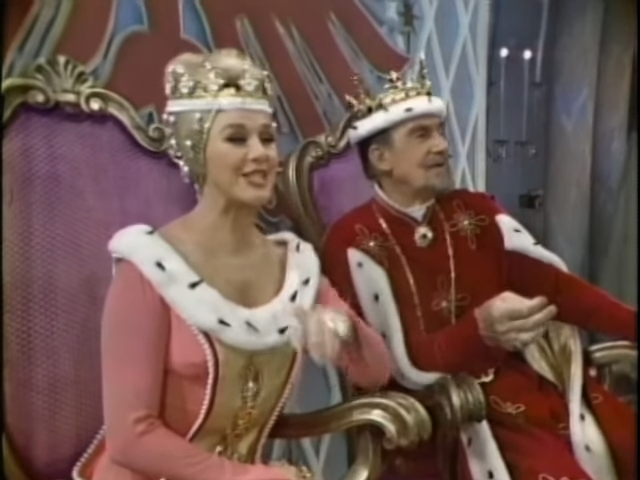
What’s more, the tone of the script doesn’t mesh particularly well with the tone of the lyrics. This Cinderella is even more of an innocent ingenue than the previous version so it’s downright jarring for her to fantasize about her stepsisters’ faces being “a queer sort of sour apple green” while she’s being “coy and flirtatious when alone with the prince.” With the fairy godmother (Celeste Holm)’s song, Impossible, the script blatantly has to write around the lyrics. In 1957, the godmother presented herself as an ordinary woman and initially kept her magical powers a secret. Here she materializes before Cinderella in a glimmer of fairy dust and explains that she is “made of all (her) most beautiful dreams and hopes and wishes,” so it isn’t very natural for her to start singing about how Cinderella’s wishes are a bunch of “folderol and fiddledy dee.” The movie tries to make it work by having her preface the song with the words, “sensible people say….” I guess that was the best fix if they couldn’t just follow the original.
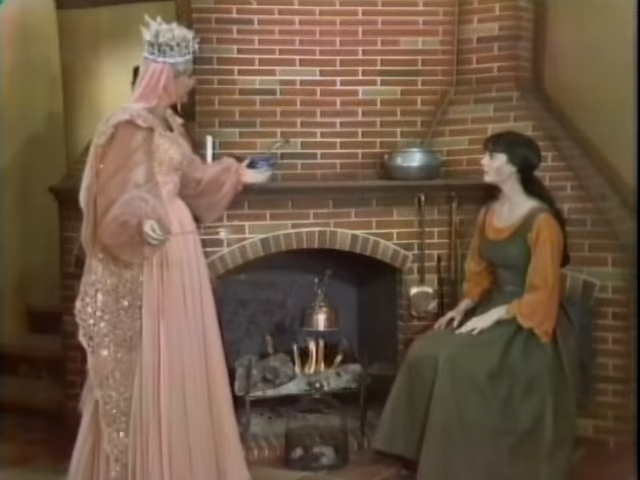
Speaking of singing, this version gives the prince (Stuart Damon) a romantic solo, Loneliness of Evening, that was cut from South Pacific, another Rodgers and Hammerstein musical. It’s a beautiful song and I’d rather it be in this movie than nowhere. But it doesn’t really fit in with the other songs, being much more serious and since the movie places it in the first scene, it arguably does a bad job of setting the tone for the soundtrack. (I’m also not sure why the prince would be “looking out on a silver-flaked sea.” There’s no such body of water in sight.)
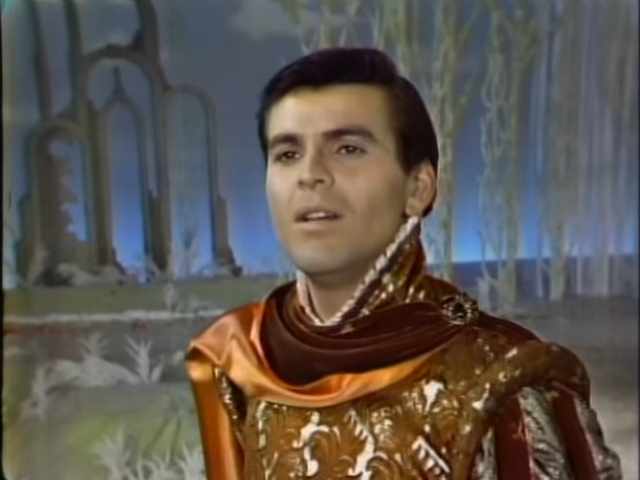
It would be wrong to say there’s no comedy at all in this version. I’ve described the stepmother as more villainous than in the 1957 Cinderella and so she is, but Jo Van Fleet’s cartoony facial expressions also make her very funny.
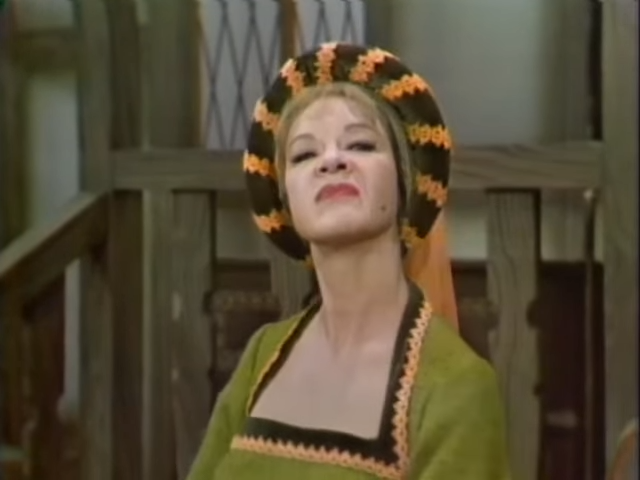
There’s also a running joke about one of the stepsisters, Esmeralda (Barbara Ruick)[8]Who played Carrie Pipperidge in the movie adaptation of Rodgers and Hammerstein’s Carousel, constantly batting her eyelashes and the knees of the other, Prunella (Pat Carroll)[9]Who voiced the sea witch in Disney’s The Little Mermaid., creaking. This can be funny though when the prince jokes about their infirmities at the ball, you may feel that he’s a jerk.
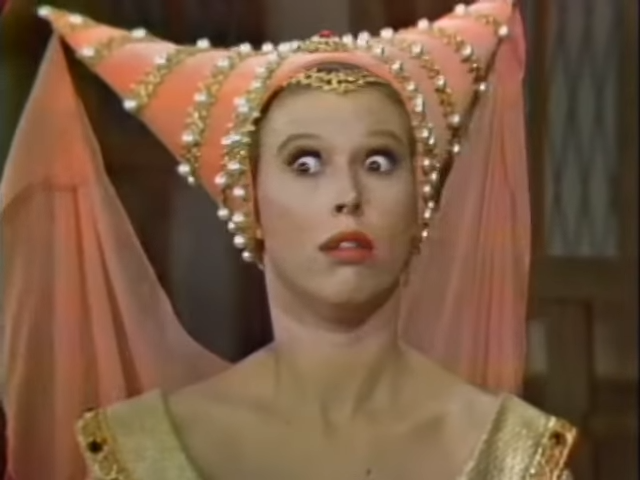
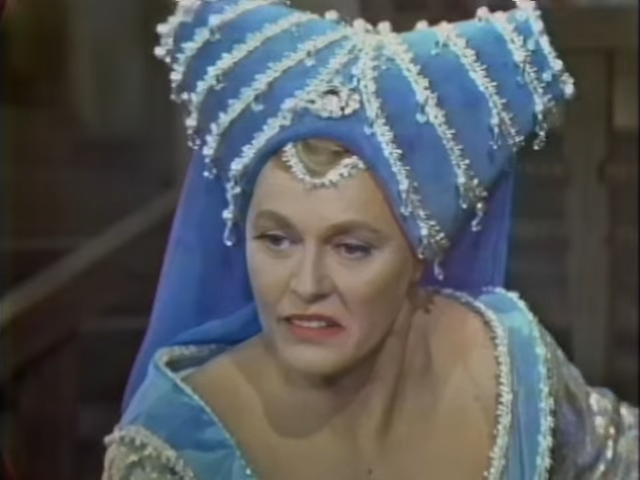
That being said, of the three actors who play the prince in the different screen versions of this musical, Stuart Damon probably has the best screen presence. And while the squeaky voice she adopts to play Cinderella annoys me, Lesley Ann Warren’s eloquent facial expressions shine.
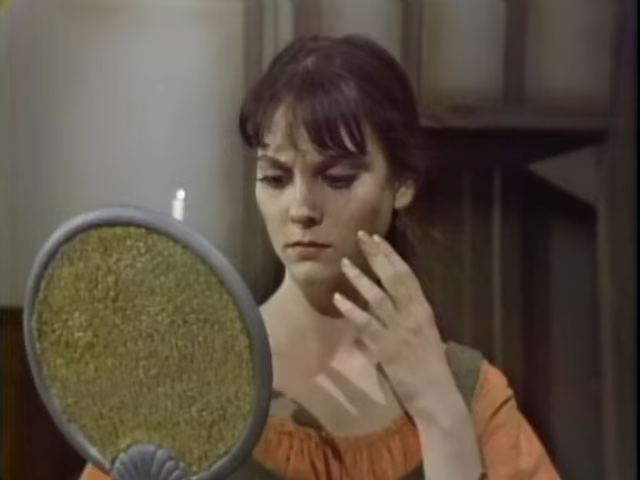
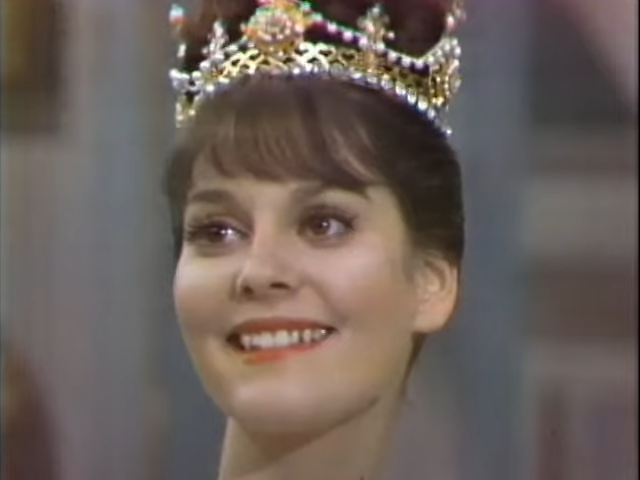
To end on a positive note, let me mention a major improvement the 1965 version of the musical makes over the previous one. In 1957, prior to Cinderella’s arrival at the ball, formal and stately (though beautiful) music accompanied a formal and stately dance[10]The technical term is gavotte. in keeping with the prince’s boredom. Then when Cinderella arrived, and he danced with her, the same music played in a livelier key. After the songs Ten Minutes Ago and Stepsisters’ Lament, the couple danced to a sweeping romantic waltz. Here that waltz is the first thing which they dance. The contrast this creates may be less subtle, but the unsubtlety honestly works better, and the 1997 movie would wisely follow suit. Each of the three films has a moment when Cinderella enters the ballroom, everyone stares at her and the prince approaches her. By eliminating all background music until the dancing resumes, this version is the one that makes the moment the most electric.
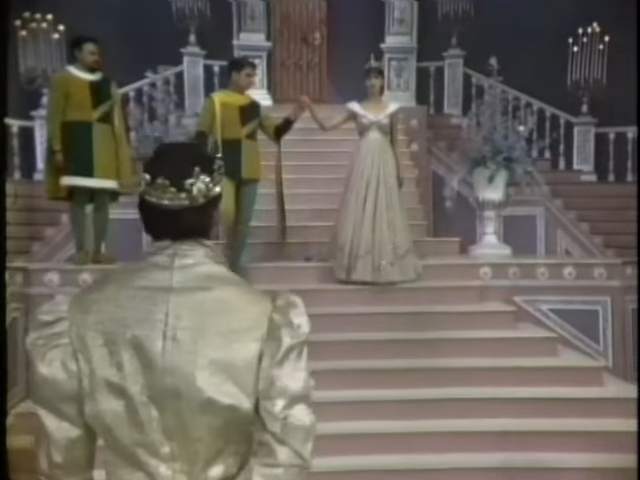
Rodgers and Hammerstein’s Cinderella (1997)
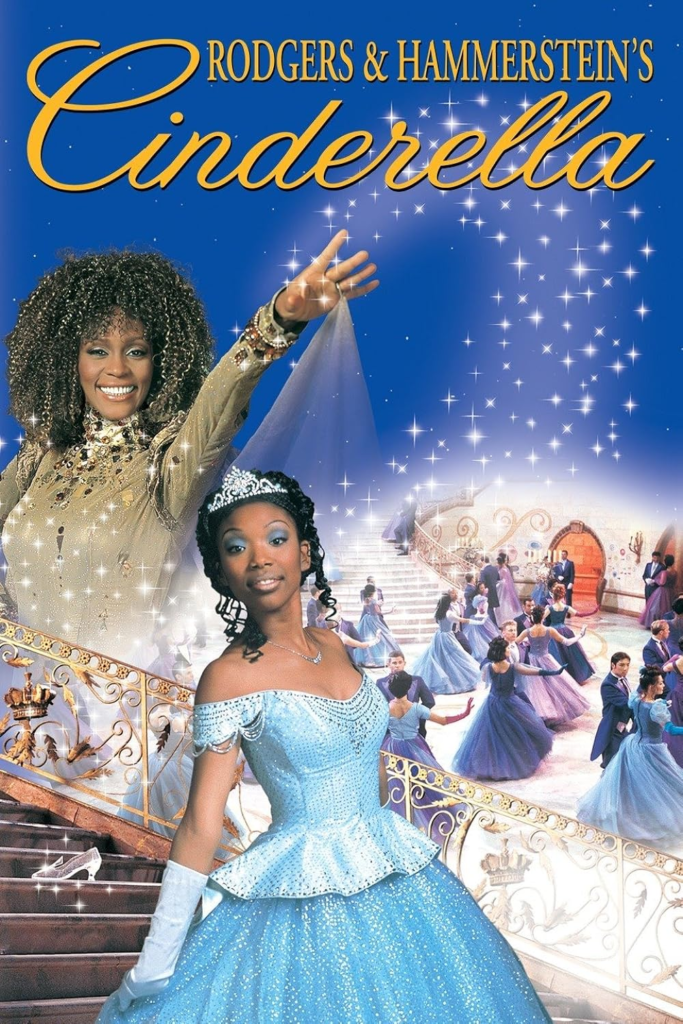
For someone who’s seen the first two screen versions of Rodgers and Hammerstein’s Cinderella, a pleasure of watching the third one directed by Robert Iscove is seeing how it incorporates elements of each of them. The first scene combines the beginning of the 1957 movie, with Cinderella (Brandi Norwood) and her stepfamily out shopping and Cinderella stuck carrying all the packages, and the 1965 one with a chance between meeting between Cinderella and the prince (Paulo Montalban) whose identity she doesn’t initially realize. The scene of the stepsisters rehearsing what they’ll do when they meet the prince is particularly packed with allusions to the earlier versions. First, they argue which of them will flutter her eyelashes and which will start with a curtsey, recalling the characters’ quirks from 1965. Then one of them, Minerva (Natalie Deselle), says she intends to impress the prince by reciting a poem like Portia the would-be intellectual stepsister in 1957. The other, Calliope (Veanne Cox), plans on charming him with her supposedly infectious laughter, bringing to mind Portia’s sister, Joy. At its best, the script by Robert L. Freedman combines the sound storytelling instincts of the 1965 one with the 1957 script’s sense of humor.

This version adds not one but three songs by Richard Rodgers to the score. Shockingly, the one with the least memorable lyrics is the only one with lyrics by Oscar Hammerstein. That would be There Is Music in You, originally written the 1953 movie Main Street to Broadway in which the famous musical duo had a cameo. Here it’s sung at the end of the film by the fairy godmother (Whitney Houston who was also a coproducer.) The “inspiring” lyrics are generic to the point of being vapid. The song was clearly a throwaway effort on Rodgers and Hammerstein’s part, and I imagine it was only put in this movie so Houston could sing more. The added songs without Hammerstein are surprisingly better. One of them is The Sweetest Sounds, which was originally from the 1962 musical No Strings and features lyrics by Rodgers himself. Here it becomes a lovely duet between Cinderella and the prince which they unknowingly sing together in the opening scene as they navigate a crowded marketplace, unaware of each other’s existence, establishing that they’re destined for each other. Not the most original idea but it works. The other new song is Falling In Love With Love, which hails from the 1938 musical The Boys from Syracuse, a collaboration between Richard Rodgers and lyricist Lorenzo Hart.[11]A musical inspired by Shakespeare’s The Comedy of Errors incidentally. It’s a fun, cynically humorous song in which the stepmother (Bernadette Peters) cautions her daughters against romance.[12]That’s its context in this movie, I mean, not in Boys from Syracuse. The lyrics of these songs naturally don’t connect to the story as organically as those written specifically for it but to my mind, they all mesh with them better than Loneliness of Evening did in 1965.

I also feel this production does the best job of adapting the classic songs. I love the way they slow down the reprise of Cinderella’s song about daydreams, In My Own Little Corner, making it melancholier and even have her voice trail off before she can finish the last line. Earlier the song sounded more genuinely cheerful but now we get the impression that Cinderella is losing the ability to take comfort in her imagination. Why didn’t the earlier two versions do that? It makes so much sense! The movie also takes advantage of Whitney Houston’s vocal cords to make Impossible a bigger showstopper than ever.

There’s only one song whose reimagining I dislike. In 1957, The Prince Is Giving a Ball was driven by Hammerstein’s clever lyrics. Here it becomes a big ensemble dance number in which the main singer, royal aide Lionel (Jason Alexander) is in constant danger of being trampled by various other servants preparing for the festivities. I suppose this was done because the only cinematic musicals that were popular in the 1990s were Disney animated ones and those typically a featured a big production number or two like this, often with an element of slapstick comedy. Other than that, this iteration of Rodgers and Hammerstein’s Cinderella has the best staged songs, thanks to choreographer Rob Marshall. Not only are they the most fun to watch out of all three movies but they’re the only ones where the staging assists the storytelling and characterizations rather than just being an ornamentation.

But then there’s the dialogue which is a mixed bag. Whenever it tries to be inspiring or romantic, it’s dreadfully trite and flat and only little kids will find it moving. I know the romantic dialogue in the 1957 movie was also cornball[13]I’d argue deliberately so. but that was good solid corn. Or maybe 50s era corn was just better than 90s era corn. Exhibit A: this dialogue between Cinderella and the prince in the original movie.
Prince: You haven’t yet told me your name.
Cinderella: It’s a silly name. You wouldn’t like it.
Prince: Whatever you are called is the most beautiful name in the world. Whatever your name is, I love you. I will always love you. You don’t say anything? I have just told you that I love you and you don’t say anything?
Cinderella: I’m afraid to. I’m afraid I might…wake up.
Prince: Are you sure you are asleep?
Cinderella: Oh yes!
Prince: Are you dreaming I’m about to kiss you? (They kiss.) I am deeply in love. And yet I don’t know why. Do you?
Cinderella: Do I what?
Prince: Do you know why I am in love? What did you think I meant?
Cinderella: I thought you said do I know why I am in love.
Prince: Are you?
Cinderella: Oh yes!
Prince: And do you know why?
Cinderella: No but I’m a girl and girls don’t care why.
Prince: I always want to know why I do anything, why I feel anything and so I ask myself why. Why is the sound of your voice the sweetest sound in the world? Why is the color of your hair the only color a girl’s hair should be? Why would I rather hold you in my arms than do anything else in the world? Why?
Compare that to the conversation between Cinderella and the incognito prince when they first meet in the 1997 movie.
Prince: Tell me, Cinderella, what would a man have to do to find himself in your good graces?
Cinderella: Who wants to know?
Prince: Let’s just say a charming stranger.
Cinderella: This charming stranger seems pretty sure of himself. But he’d have to get to know me a lot better than some girl he just met on the street.
Prince: Oh, but he’d like to! Very much!
Cinderella: Oh my. I’m not sure I want to meet this stranger. I doubt if he has any idea how a girl should be treated.
Prince: Like a princess, I suppose.
Cinderella: No. Like a person, with kindness and respect.
Prince: You’re not like most girls, are you?
Arrgh! It’s such bad dialogue! And yet I really like this movie. And I don’t think that’s just 90s kid nostalgia.[14]Amusingly, that line of thought recalls the lyrics to one of this musical’s songs. Do I love it because it’s beautiful? Or is it beautiful because I love it?
You see, while the script usually falls flat when it tries to be serious, whenever it tries to be funny, it’s brilliant. Take this exchange between the king (Victor Garber) and the queen (Whoopi Goldberg) at the ball. For context, their son has agreed to attend on the condition that if he doesn’t meet the love of his life there, they’ll leave him to his own devices.
Queen: So many beautiful girls! He’ll find the one he’s looking for tonight, I’m sure of it.
King: And if he doesn’t?
Queen (through gritted teeth) This ball will never end.
Lionel: I don’t think we ordered enough food.

The same scene features the stepmother flirting with Lionel unsuccessfully.
Stepmother: Look at you! That manly physique, those handsome chiseled features, that wonderful full head (notices he’s balding) of skin.
Lionel: No touching, please.
Stepmother: Surely, there’s no need to pretend. I know that you’ve felt that certain something between us.
Lionel: You know, I honestly wish there was something between us.
Stepmother: You do?
Lionel: Yes. A continent.
In fact, the whole scene of the ball prior to Cinderella’s entrance is hilarious. The scene of the stepsisters trying on the glass slipper is also the funniest version not only in any of these movies but in any Cinderella movie period.

This movie also benefits from strong casting. Brandi Norwood is sweetly appealing as Cinderella, and she even manages to transcend the lame dialogue she’s given. (Paul Montalban doesn’t transcend his but that may just be because the prince is a worse written character.)

Cox and Deselle outshine any of the actresses who played the stepsisters in previous versions. But Bernadette Peters outshines the previous portrayals of the stepmother even more so, making her every line memorable and stealing every scene with her in it. Sure, her performance is pure ham-sweet, succulent juicy ham. With this kind of musical, I feel that’s the right way to play it.

Conclusion
So which of these movies is the best? My heart wants me to vote for the 1997 one but the 1957 version has the easily the most consistently great script. It’s a pity that it’s practically impossible for modern viewers (besides me, I mean) to enjoy it. Then again, the theme of this musical is “impossible things are happening every day.”
You know what else is possible these days? Listening to the soundtrack of each of these movies on YouTube. Cheers!
References
| ↑1 | I much prefer the filmed staging of that show from 2000. See my blog post for details. |
|---|---|
| ↑2 | The 1997 movie unwisely incorporates part of it into The Prince Is Giving a Ball with new lyrics. |
| ↑3 | To understand why the name Portia is ironic for a dumb character, check out The Merchant of Venice. |
| ↑4 | Perhaps because Lindsay and Stickney were a couple in real life. |
| ↑5 | Do I really need to name her? |
| ↑6 | Interestingly, Hammerstein wrote a stage version, not to be confused with the 2013 Broadway version with a book by Douglas Carter Beane, that fixes this somewhat. |
| ↑7 | They’re really more like work clothes but never mind. |
| ↑8 | Who played Carrie Pipperidge in the movie adaptation of Rodgers and Hammerstein’s Carousel |
| ↑9 | Who voiced the sea witch in Disney’s The Little Mermaid. |
| ↑10 | The technical term is gavotte. |
| ↑11 | A musical inspired by Shakespeare’s The Comedy of Errors incidentally. |
| ↑12 | That’s its context in this movie, I mean, not in Boys from Syracuse. |
| ↑13 | I’d argue deliberately so. |
| ↑14 | Amusingly, that line of thought recalls the lyrics to one of this musical’s songs. Do I love it because it’s beautiful? Or is it beautiful because I love it? |
